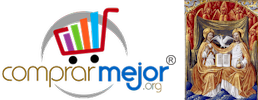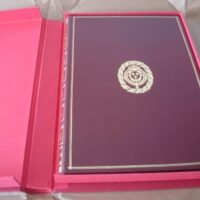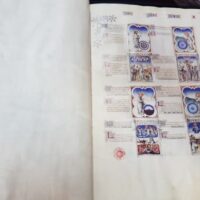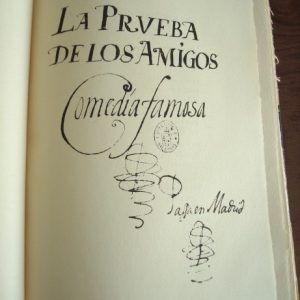Description
Original kept in the National Library of France, signature Ms. Fr. 166. XV century (circa 1402-1404). Written in Latin. It contains 513 miniatures illuminated with gold and silver entirely by the Limbourg brothers, to which must be added 255 illustrations by Jean Fouquet and other brilliant artists of the illumination of manuscripts between the end of the 14th and the beginning of the 15th century, all in 100 pages of parchment of which this extraordinary and beautiful codex is composed. Dimensions 29 x 41.5 cm.
Considered by many to be the most richly illuminated codex of the Limbourg brothers with 768 splendid illustrations.
The Duke of Berry and the Limbourg brothers linked their names to art history. The former was the most famous bibliophile of his time, and the Limburgs entered his service as illuminators of his court in 1405, performing years later The Very Rich Hours of the Duke of Berry, which together with this Bible constitute his famous masterpieces.
Bound in red leather on a table with embossed gold ornamentation with the arms of the kings of France, in whose Library of Blois it entered through King Charles VIII.
The famous Limbourg brothers are the authors of most of his illuminations, being the first of his great masterpieces and the one with the largest number of illustrations.
Its history dates back to the dawn of 1402, when the Limburgs entered the service of Philip the Bold, Duke of Burgundy, brother of Jean, Duke of Berry and Charles V, King of France. We could say that Philip the Bold was the discoverer or headhunter of Herman, Paul and Jean de Limbourg thanks to his exquisite taste, refinement, passion and patronage of the arts. The Duke of Burgundy commissioned them to enlighten the present Moralized Bible, a type of Bible that narrates the Holy Scriptures through medallions and explains it with attached texts.
The Moralized Bibles were by far the most ambitious attempt ever undertaken to illustrate the Bible and an accompanying commentary. With the sudden death of the Duke in 1404 and without a patron to continue this ambitious artistic project, the Limburgs moved to the court of their brother Jean, Duke of Berry. Years later, René de Anjou hired other great artists who added illustrations to the manuscript. The facsimile fully reproduces this original and really attractive part from the artistic point of view.
Unique facsimile edition, limited to 999 numbered and notarized copies. This specimen is presented in an exclusive book-style case, lined in red leather, spine with title and gold, handcrafted specifically for him. Format 35 x 47 x 5 cm.
It is accompanied by the corresponding study book, bound in hard cover with illustrated dust jacket, format 25 x 34 cm. 98 pages in Spanish, English, Italian and German. Studies by Eberhard König and John Lowden.
This edition obtained in 2011 from the Ministry of Culture, the First National Prize for the Best Edited Facsimile for Patrimonio Ediciones, the publishing house that with great mastery made this extraordinary work and made it available to bibliophiles, collectors, libraries and art lovers, history and culture in general.
Complete, exclusive and in perfect condition.
Shipping costs for the account of the buyer, according to order and destination. Ask us without obligation (indicating the reference of the article) any questions.






























